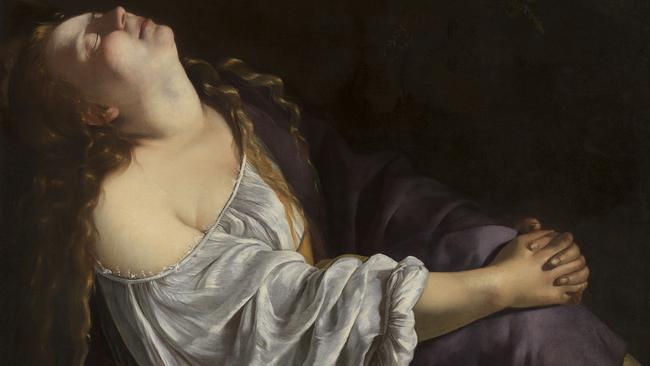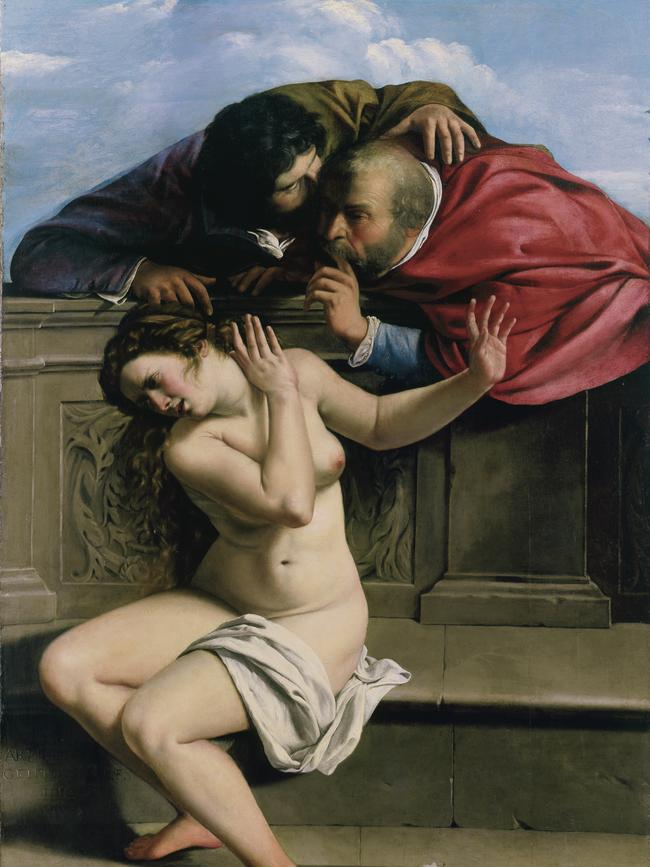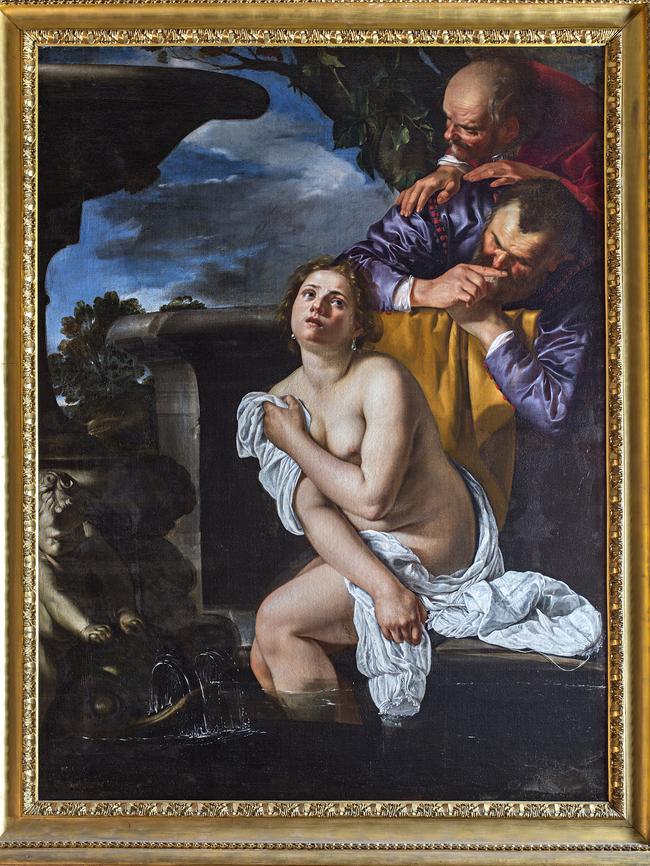Artemisia Gentileschi at London’s National Gallery
While skilled female painters were rare in the 17th century, Artemisia Gentileschi made sure her works and her story would not be forgotten.

Women artists were rare in the early modern period, and they often worked within limited and specialised fields, such as flower painting or miniature. They were not however, as is often claimed, suppressed or written out of art history. Some, like Artemisia Gentileschi, were celebrated, well-connected at the highest levels of society and had successful careers; for them, being a woman painter was a positive asset, an intriguing difference that made them stand out among other artists of comparable ability.
If such artists were subsequently forgotten, it was not because of some conspiracy to expunge them from the record. The reasons are more banal.
In the first place, the perspective of history soon diminishes the apparent significance of all but the most important figures in any field. Reasonably educated people today can cite perhaps half a dozen painters of the Renaissance; most of the artists, writers, politicians and others that we know today will be, deservedly or not, largely forgotten in a century.
The other factor in the case of Artemisia in particular was the change of taste away from styles of painting derived from Caravaggio, from the mid 17th century, and then the broader reaction against baroque painting, with its theatrical treatment of scriptural subjects, from the mid 18th century. Many others were swept into oblivion during the ages of neoclassicism, romanticism, realism and impressionism. In art history, the 19th century loved the middle ages and the early renaissance; late renaissance and mannerist art were only rediscovered in the early 20th century, and the baroque in the second half of the century.
It was an essay by the great Italian art historian Roberto Longhi in 1916 that drew scholarly attention to the work of Orazio Gentileschi and his daughter Artemisia, and subsequently an historical novel based on her life by Longhi’s wife, published in 1947, that brought her to the notice of a wider public.
As the most important female artist of the early modern period, and one with a dramatic life story, she naturally appealed to feminist art historians, and for a couple of generations of art students Artemisia became a two-dimensional cutout like Frida Kahlo.
Some of her letters had been published in Bottari’s famous anthology of artists’ correspondence in 1754, and further groups of letters to patrons and clients were published from the late 19th to the mid-20th century. All of these were dictated to secretaries, because Artemisia had barely learnt to read and write until her 20s. In 2011, however, Francesco Solinas, a colleague of mine at the College de France in Paris many years ago, discovered a collection of autograph letters which revealed a passionate affair and a more complex personality than we had previously known.
This discovery has stimulated a new interest in the artist and has led to several recent exhibitions, of which the most important is the one that has just opened in London at the National Gallery.
Again, travel restrictions make it impossible for any of us to visit London at the moment, but there are online resources available and the catalogue is an outstanding work that includes excellent essays by Elizabeth Cropper, Patrizia Cavazzini, Francesco Solinas, Letizia Treves, Sheila Barker and Larry Keith.
As Elizabeth Cropper says towards the end of her essay, “It was easier to write about Artemisia Gentileschi when we knew less of her story and, whether as a connoisseur, a feminist, or a social historian, we could impose a narrative upon her.” As usual, however, the truth is both more complicated and more interesting. Artemisia’s story takes us deep into the world of 17th-century art from the perspective of a woman striving to make a successful career in that environment.
She was born in Rome in 1593, the daughter of a Tuscan painter, Orazio Lomi, who came from Pisa and adopted his uncle’s surname, Gentileschi, when he moved to Rome as a teenager; this explains why Artemisia herself sometimes signed her work with the original family surname.
Orazio was not himself an artist of the first rank, but he was living in the most dynamic centre of modern art and was soon influenced by his great contemporaries in Rome, Annibale Carracci and Caravaggio.
Nor was he an educated man, which is no doubt why he did not teach his daughter to read and write, but he certainly recognised her artistic talent and probably started giving her drawing lessons at around the age of 13 and teaching her painting from about 16. The usual way to learn painting at the time was by being apprenticed to a master and living in his house with other apprentices; this was obviously unthinkable for a teenage girl, so virtually the only way a girl could be trained as an painter was to be taught by an artist father.
Another handicap that girls faced was not being allowed to attend life drawing sessions with naked male models and yet another, as one of the contributors to this volume reminds us, was not being able to walk freely around Rome sketching antiquities and copying from the frescoes of Raphael, Michelangelo and other great modern artists. On top of all that, Artemisia was responsible for looking after her younger brothers after her mother died when she was only 12.
But even though the young Artemisia was kept at home, she was raped in May 1611, at the age of 17 — according to her own later graphic testimony — by Agostino Tassi, a 33-year old painter and her father’s collaborator. After this they continued a relationship for some months, on the understanding that Tassi would marry her; when he did not, Orazio brought a formal charge of rape, no doubt in an attempt to force his hand. But Tassi called his bluff and the case went to court, where the rape charge was undermined by the testimony of several witnesses that Artemisia had already slept with other men. She and others were questioned under torture with a thumbscrew; in the end Tassi was found guilty, sentenced to exile but soon released.
Immediately after this, Orazio arranged for her to marry the brother of their legal counsel, an otherwise-forgotten Florentine painter called Stiattesi. By early 1613 they were in Florence, where they lived until 1620. There Artemisia had five children, of whom one daughter ultimately survived to be married later in her turn. After this, as the new letters reveal, from around the age of 25, she started a passionate affair with a Florentine nobleman, Francesco Maria Maringhi, and Stiattesi seemed content to assume the role of marito compiacente, even writing to Maringhi on her behalf. As several authors in the catalogue repeat, she was ambitious and both she and her husband were unscrupulous in their determination to get ahead socially and financially.
Artemisia’s talent was recognised in Florence, and she rapidly educated herself in the sophisticated company of the highly-cultivated Medici court. She was admitted to the prestigious Accademia del Disegno at only 23 years old, and already at 22 was paid three times more than the other artists employed on the collective commission for Casa Buonarroti.
Her mature work belongs especially to the years after her return to Rome in 1620. She was in Venice around 1627-30 and thereafter in Naples from 1630 to the end of her life in 1654 or 1655, except for a period of two years when she joined her father Orazio in London and helped him to complete his final commission at the court of Charles I.
Over the course of these years we see her style evolve as she assimilates successive influences. Her first attested work, Susannah and the Elders (1610), is painted in her father’s style and probably with his help.

Another version of the same subject in 1622 shows her emulating the style of Guercino, the brilliant Bolognese painter who was in Rome during the brief papacy of the Bolognese Pope Gregory XV Ludovisi (1621-23). Later there are pictures that reflect Venetian influences, and especially in the last period, she adapts to the post-Caravaggesque manner of Naples.
What is perhaps most important, however, is the repertoire of subjects that Artemisia chose to paint. The most famous one, endlessly reproduced in textbooks, is Judith and Holofernes, originally staged in this dramatic way by Caravaggio around 1599.
Artemisia’s first version, now in Naples, was probably made in Rome before her move to Florence, while the second, painted not long after — the figures are reproduced by tracing — was executed in Florence and reflects the Florentine love of elaborate costume.
In what has become the dominant cliche, this painting expresses her rage and desire for revenge on Tassi. Almost all recent scholars have agreed that this is simplistic, apart from the absurdity of reducing Artemisia to little more than an embittered victim of rape. Besides, the protagonist of this story is not a victim of sexual aggression; she is on the contrary a seductress who has used her attractions to gain the confidence of Holofernes before murdering him.

When we look at the whole repertoire of Artemisia’s subjects, many of which she painted several times, we can see how she is consciously playing to her strengths as a woman painter. In the first place, the main figures are always women, more or less naked, which suits her far better understanding of female than of male anatomy. But above all, these figures tell stories of essentially female moral predicaments.
They are usually women in some kind of vulnerable relation to men: apart from those already mentioned, the death of Cleopatra, Danae and the golden shower (tracing the same figure), Bathsheba at her bath, Mary Magdalene (including a new attribution, very close to Caravaggio’s treatment of the same subject), the suicide of Lucretia, Lot and his daughters (a recent and more questionable attribution), and even, intriguingly, Joseph and the wife of Potiphar, the story of a woman who tries to seduce a young man and then falsely accuses him of rape.
All of these subjects have an erotic charge, and indeed sit on the cusp of eroticism and moralising. But what makes them even more interesting is that Artemisia so often includes more or less explicit self-portraits in the compositions, as though she were an actress performing successive roles.
And here she is not merely exploiting the fact of being a woman painter, but of being a woman whose sexual history, from the sensational court case to adultery and cuckolding her husband, was notorious.
Using her own features was “a conscious act of self-promotion”, as Letizia Treves writes in a perceptive essay. Artemisia “was fully aware of the added desirability — and titillation, in the case of full or partial nudity — for seventeenth-century collectors of owning a Susannah, Judith or Cleopatra not just painted by a woman artist but also resembling her”.
Artemisia Gentileschi, National Gallery (London), until January 24, 2021.




To join the conversation, please log in. Don't have an account? Register
Join the conversation, you are commenting as Logout